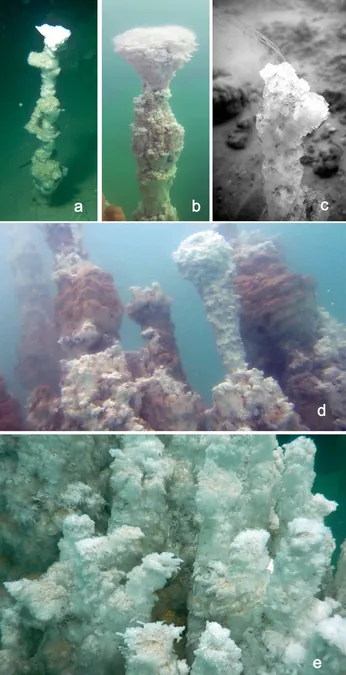
Astonishing Discovery of White Smokers in the Dead Sea: Nature's Mysterious Venting System Uncovered!
2024-11-14
Author: Rajesh
Introduction
In a groundbreaking research initiative led by the Helmholtz Centre for Environmental Research (UFZ), scientists have unveiled an extraordinary phenomenon on the floor of the Dead Sea: towering chimneys resembling 'white smokers.' These stunning formations, identified for the first time, emerge from the spontaneous crystallization of highly saline groundwater that flows upward from beneath the lake, as detailed in the journal *Science of the Total Environment*.
Significance of White Smokers
These geological wonders are more than just captivating; they serve as vital indicators of impending sinkholes. The area around the Dead Sea is notorious for these craters, which can reach widths of up to 100 meters and depths of about 20 meters, posing a significant threat to local communities and infrastructure.
Environmental Changes
The Dead Sea itself is a remarkable and shifting environment. For over five decades, its water level has been dropping at an alarming rate of nearly one meter per year due to reduced water inflow from tributaries and increased evaporation exacerbated by prolonged drought conditions. Currently, the lake sits roughly 438 meters below sea level. This drastic decline has profound implications for the region's groundwater, further complicating access to water resources amidst a worsening climate crisis.
Research Insights
Leading the charge in understanding groundwater dynamics, UFZ hydrogeologist Dr. Christian Siebert has initiated extensive research into how aquifers in this region are evolving. A team of skilled divers recently discovered these unusual chimney formations, which release a shimmering, saline fluid into the Dead Sea. "These chimneys are reminiscent of the black smokers found at mid-ocean ridges, but the underlying processes are distinctly different,” explains Dr. Siebert.
Mechanism of Formation
While black smokers emit hot, sulfide-rich water from the ocean floor, the new white smokers in the Dead Sea expel super-salty groundwater. But what drives this curious process? The answer lies in the surrounding freshwater aquifers, which penetrate saline lake sediments, leaching ancient rock layers of halite (salt). This briny water rises towards the surface due to its lower density compared to the heavier waters of the Dead Sea, creating the illusion of smoke, even though it consists entirely of dissolved salts.
Growth of Chimneys
Remarkably, contact with the Dead Sea water causes these dissolved salts to rapidly crystallize, forming the impressive chimneys which can grow several centimeters in just one day. While most of these structures range from one to two meters in height, some giants soar to more than seven meters tall with diameters spanning two to three meters.
Radioactive Isotopes and Microbial Life
Further analysis has revealed traces of a radioactive isotope called 36Cl, indicating these chimneys are linked to the surrounding aquifers. Moreover, genetic testing has confirmed the presence of freshwater microbes within the chimney water, demonstrating the unique origin and transition of these fluids just before entering the Dead Sea.
Implications for Sinkhole Prediction
These white smokers hold immense significance beyond their visual allure; they could revolutionize our ability to predict sinkhole formations. Dr. Siebert emphasizes, "To date, predicting sinkhole locations has been nearly impossible, but these formations provide essential clues. They highlight regions where karstification—the dissolution of salt layers—has occurred extensively, indicating a higher risk of future collapses."
Technology for Future Monitoring
As thousands of sinkholes form around the Dead Sea, the need for effective forecasting tools has never been greater. Autonomous underwater drones equipped with advanced mapping technologies, such as multibeam echosounders and side-scanning sonar, could provide critical insights into these chimney formations. "This innovative method could be instrumental in identifying high-risk areas, allowing us to anticipate and mitigate the impacts of sinkholes," says Dr. Siebert.
Conclusion
This captivating discovery not only enriches our understanding of the Dead Sea's geology and hydrology but also underscores the urgent need to monitor and respond to the environmental changes that threaten this unique ecosystem and the communities that depend on it. Keep an eye on these white smokers—they may be the keys to unlocking safer living conditions in the region!


 Brasil (PT)
Brasil (PT)
 Canada (EN)
Canada (EN)
 Chile (ES)
Chile (ES)
 España (ES)
España (ES)
 France (FR)
France (FR)
 Hong Kong (EN)
Hong Kong (EN)
 Italia (IT)
Italia (IT)
 日本 (JA)
日本 (JA)
 Magyarország (HU)
Magyarország (HU)
 Norge (NO)
Norge (NO)
 Polska (PL)
Polska (PL)
 Schweiz (DE)
Schweiz (DE)
 Singapore (EN)
Singapore (EN)
 Sverige (SV)
Sverige (SV)
 Suomi (FI)
Suomi (FI)
 Türkiye (TR)
Türkiye (TR)